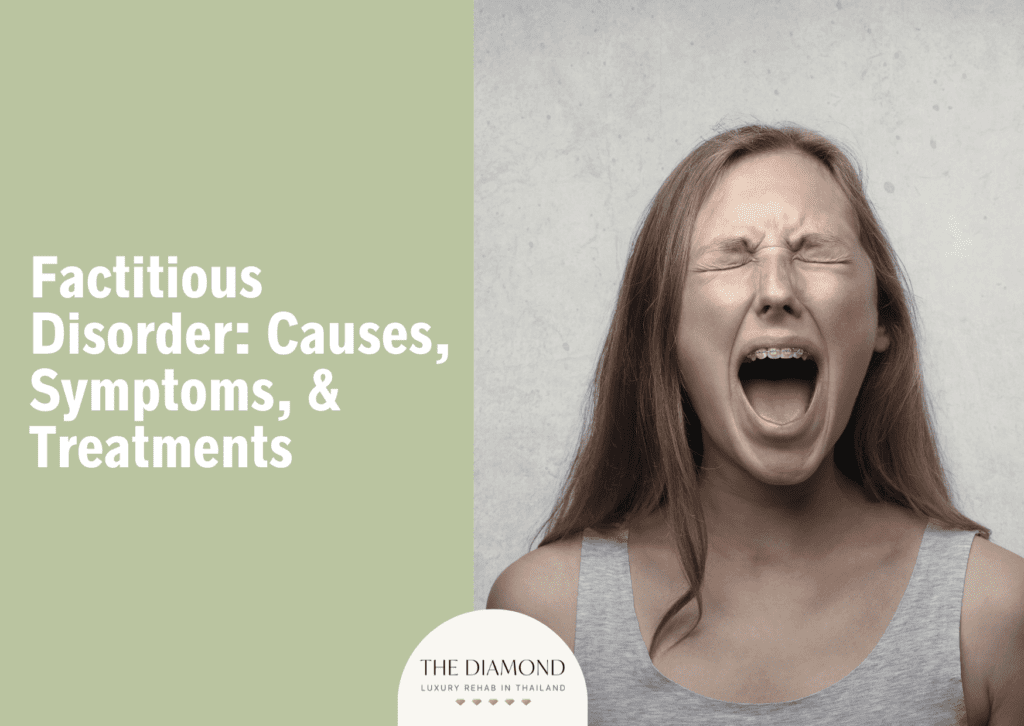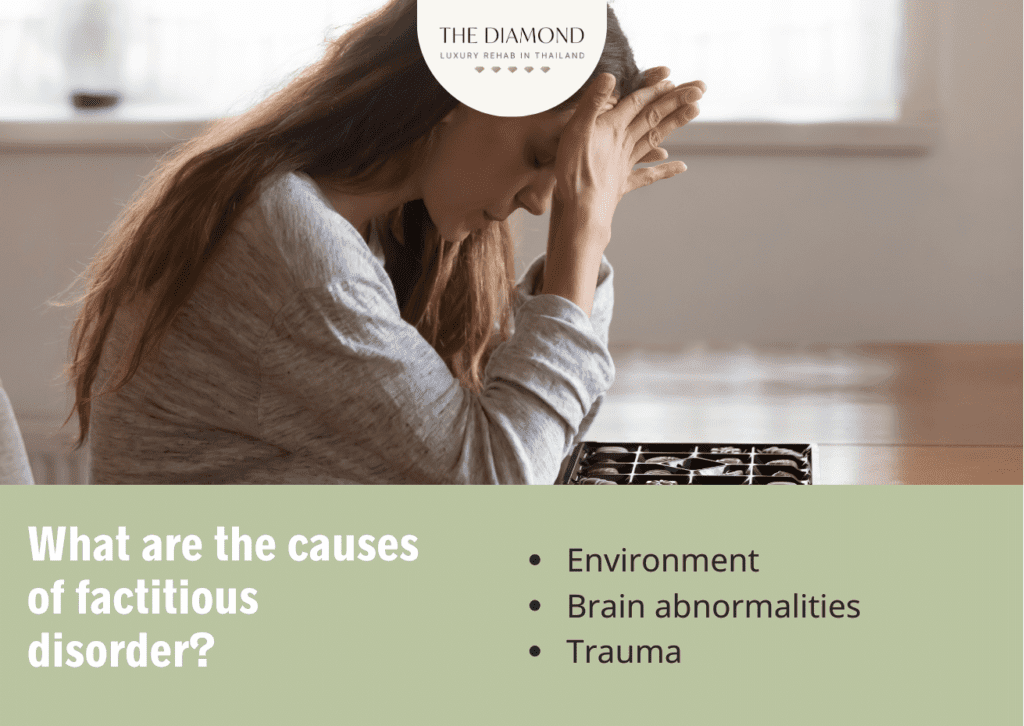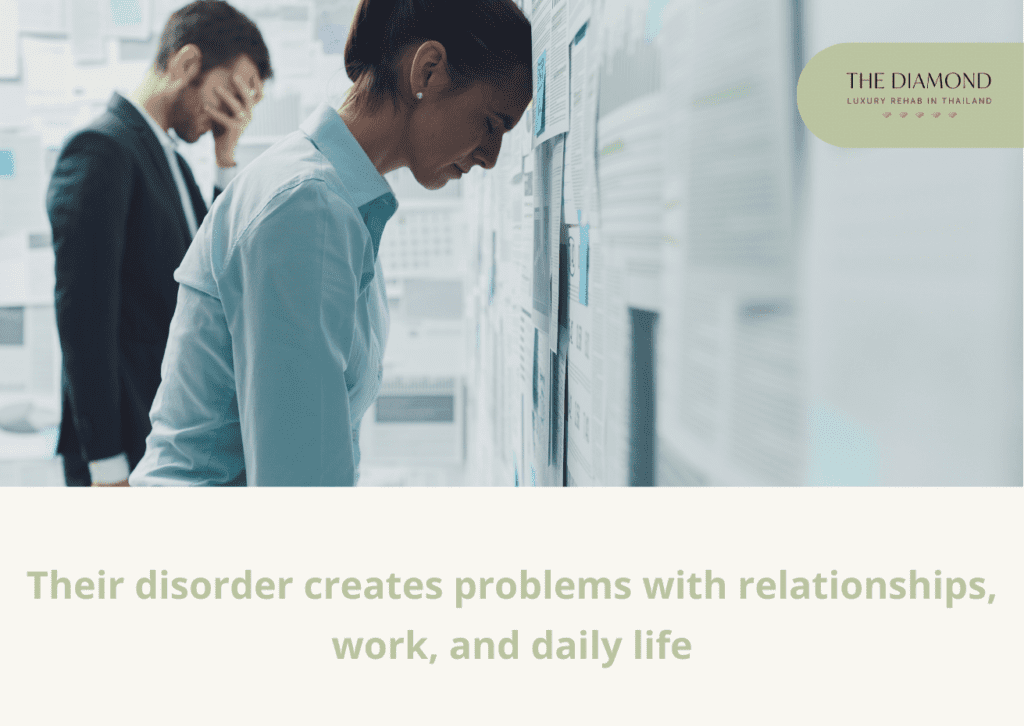Factitious disorder: causes, symptoms, and treatments

Factitious disorder is a rare type of mental health problem indicated by pretending to have a physical or psychological illness or injuring oneself on purpose just to appear sick. A person with a factitious disorder is aware they’re not sick, but they have the compulsive need to pretend that they are. Factitious disorder is known as Munchausen’s syndrome.
The causes of the factitious disorder are unknown. Trauma plays a major role in the development of this disorder, which usually occurs in young adulthood. Other factors include having a family member with this disorder, low self-esteem, and working in healthcare.
Symptoms of factitious disorder revolve around mimicking symptoms of an illness, exaggerating symptoms, or claiming treatments don’t work. A person with this disorder goes to multiple hospitals and clinics or see different doctors. They use fake names and agree to potentially risky procedures. Patients frequently stay in the hospital, even without any specific diagnosis.
Treatments for the factitious disorder include therapy and medications to manage disorders that co-occur with the condition. To encourage a patient with a factitious disorder to get help or undergo treatment, it is important to communicate with them without judging.
What is factitious disorder?
Factitious disorder is a serious mental health disorder wherein a person intentionally falsifies psychiatric or medical symptoms. The word factitious comes from the Latin adjective factitious, meaning artificial or made by art.
An individual with a factitious disorder deceives other people by appearing sick or getting sick on purpose and by self-injury. Certain people with this disorder act as if they have a mental health condition, even though they don’t.
Factitious disorder isn’t a dissociative disorder because the latter refers to cases when people experience disconnection and lack of continuity of thoughts, surroundings, memory, and identity. They escape reality in ways that are unhealthy and involuntary. A person with a factitious disorder is aware of their behaviors and knows they are pretending to be sick, but they can’t stop.
The average age at which adult factitious disorder manifests is typically in the early twenties; however, approximately half of all cases may initiate during adolescence, as per a 2006 review by Jaghab et al., published in the journal Psychiatry (Edgmont). Most people with these mental disorders start developing signs between 15 and 20 years of age.
Otherwise known as Munchausen’s syndrome, factitious disorder is classified under somatic symptoms and related disorders in the Diagnostic and Statistical Manual of Mental Health Disorders, fifth edition (DSM-5) by the American Psychiatric Association.
The disorder was initially recognized as a formal diagnostic category back in 1980 when DSM-3 was published. Later, in DSM-4-TR (2000) the disorder was classified into three major subtypes. With the publication of DSM-5 (2013), factitious disorder is divided into two types. The New edition additionally modified the description and diagnostic criteria, according to a case report by Zeshan et al., published in the September 2018 issue of The American Journal of Psychiatry.
Factitious disorder isn’t a modern-day mental health problem. Descriptions of symptoms of what is today known as factitious disorder first appeared in medical literature in the early 2nd century AD. However, the term factitious was coined in 1843.
In 1951, an eminent British endocrinologist, Richard Asher, was the first person to describe this disorder and named it Munchausen’s syndrome in an article published in The Lancet.
The first time factitious disorder appeared in the International Classification of Diseases (ICD) by World Health Organization (WHO) was in ICD-9 (implemented in 1979). The disorder is included in ICD-11 as well, from 2019.
How common is factitious disorder?
Factitious disorder isn’t common, with estimates ranging from 0.6% to 3% of general medicine referrals to psychiatry and from 0.02% to 0.9% of cases assessed in specialty clinics, according to a 2017 study by Caselli et al., published in Psychology Research and Behavior Management.
The report added that the exact prevalence of the disease is unknown. In other words, while considered rare, the exact number of people who have this disorder is undetermined.
What are the causes of factitious disorder?

The exact causes of the factitious disorder are unknown. A combination of biological and psychological causes is possibly behind this disorder. Potential causes of the factitious disorder are listed below.
- Environment: A person’s environment contributes to the development of the factitious disorder. This is particularly the case for people growing up in families where parents or other family members have this condition. They develop factitious disorders due to their upbringing or mimicking their behaviors, accepting them as normal, rather than genetics.
- Brain abnormalities: Although a lot more research on this subject is necessary, brain abnormalities tend to contribute to the development of a factitious disorder.
- Trauma: Traumatic experiences in childhood pave the way for factitious disorder. Appearing sick on purpose serves as a coping mechanism for an individual who has been neglected or abused.
What are the symptoms of factitious disorder?
Symptoms of factitious disorder vary from one patient to another or depend on the type of factitious disorder. The most common signs and symptoms of factitious disorder are listed below.
- Extensive knowledge about diseases and medical terms associated with them
- Worsening of a “health problem” for no apparent reason
- Inconsistent or vague symptoms
- The supposed “health problem” doesn’t respond to standard treatment
- Arguing with healthcare professionals e.g., hospital staff, doctors
- Having few or no visits at all to the hospital
- Going to different hospitals or doctors to seek treatments for several health conditions
- Using a fake name to seek treatments
- Frequent hospital stays
- Refusing to allow doctors to speak to family members or other healthcare professionals
- Eagerly agreeing to risky surgical procedures or frequent testing
- Altering diagnostic tests by contaminating urine samples or tampering with a wound to prevent healing
What are the different types of factitious disorder?
Different types of factitious disorders are categorized based on the symptoms that patients present. There is another categorization of two types in DSM-5, as listed in the table below.

| Type of factitious disorder | Description | Types of the factitious disorder according to DSM-5 | Description |
Factitious disorder with mostly psychological symptoms | People with this disorder mimic behavior that is typical for an individual with a mental illness such as schizophrenia. | Factitious disorder imposed on self | Classic case of a factitious disorder; when a person seeks attention or sympathy by falsifying their illness. |
| Factitious disorder with mostly physical symptoms | People with this type of factitious disorder appear physically sick and claim they have symptoms of a specific disease. For example, they act like they have chest pain, fever, or stomach problems. | Factitious disorder imposed on another | Falsely claiming another person has a physical or psychological illness. |
| Factitious disorder with both psychological and physical symptoms | Patients with this disorder claim they have symptoms of a physical illness and also mimic behaviors linked to a mental health disorder. | ||
| Factitious disorder not otherwise specified | Involves fabricating or producing symptoms of illness in another person under their care. |
1. Factitious disorder imposed on self
Factitious disorder imposed on self, known as Munchausen’s syndrome, is the act of falsification of symptoms (physical or psychological) without an evident external incentive. That means they don’t do this for financial or material gain, not even to get time off work.
The main motivation for this behavior is to appear sick or unwell. People with this type of factitious disorder often claim their symptoms appeared suddenly or they describe them as dramatic. They have unstable relationships and problems with their identity.
They are intelligent and resourceful. For that reason, persons with factitious disorders learn a lot about various health problems and gain extensive knowledge.
People with factitious disorders imposed on themselves engage in potentially dangerous behaviors just to appear sick. For instance, they persuade a doctor to undergo a risky surgery. Others ingest substances or inject various chemicals into their bodies to induce injury or symptoms of certain health problems.
It is important to clarify that factitious disorder imposed on self isn’t the same as hypochondria. A hypochondriac believes they’re ill. A person with this disorder, however, knows they aren’t sick but they have the pathological need to pretend and act like they are.
2. Factitious disorder imposed on another
Factitious disorder imposed on another, known as Munchausen syndrome by proxy, is when a person falsely claims the other individual is physically or psychologically sick. They cause injury to that person in order to deceive others.
A good example of a factitious disorder imposed on another is when moms or fathers harm their children to receive attention or lie about their child’s health, pretending as if they are struggling with various health concerns.
This type of factitious disorder puts the other person, usually a child, in serious danger. Harming a child to make them appear sick is abuse. It additionally puts a child at high risk of unnecessary medical procedures and treatments.
To other people, a person with this disorder appears concerned and protective. However, children (or other people under their care) usually have a history of frequent hospitalizations and multiple tests without a specific diagnosis.
What effects does factitious disorder have on a person’s life?

Factitious disorder has a multitude of effects on a person’s life, especially when left unmanaged. A 2019 article from Mayo Clinic titled, “Factitious disorder” stated that people who suffer from factitious disorder are prepared to put themselves in harm’s way in order to appear sick.
Their disorder creates problems with relationships, work, and daily life. There tends to be a lot of disagreements between a patient with this condition and their partners or other family members who are aware the person isn’t sick.
Other effects of the factitious disorder include loss of limbs or organs due to unnecessary surgeries, severe health problems from infections or unnecessary procedures, substance abuse, and injury or death from self-inflicted conditions. In cases of factitious disorder imposed on another, abuse is yet another important but dangerous effect of this mental illness.
What are the risk factors for factitious disorder?
Risk factors for factitious disorder involve conditions or circumstances that predispose an individual to develop or exhibit symptoms of the disorder. The risk factors for factitious disorder are listed below.
- Experiencing trauma in childhood e.g. neglect, physical or sexual abuse
- Having experienced a serious illness that required several hospitalizations in childhood
- Low self-esteem
- Poor sense of identity
- Strong desire to be associated with healthcare professionals and medical institutions
- Working in healthcare
- Presence of another mental health illness such as depression and personality disorder
- Past experiences during times of sickness and attention they brought
- Loss of a loved one through illness, abandonment, or death
- Having a seriously ill relative
- Marriage problems
- Substance abuse
How is factitious disorder diagnosed?
Factitious disorder is diagnosed through a detailed interview, evaluation of past medical records, working with family members and friends to obtain more information, and checking whether the patient’s symptoms meet the criteria from DSM-5.
Criteria from DSM-5 include the absence of a believable reason for injury or illness, medical history makes no sense, illness doesn’t follow the usual course, lack of healing for no apparent reason, inconsistent or contradictory symptoms, resisting getting information from previous medical records, and getting caught in the act of causing an injury or lying.
Deceptive behaviors make it difficult to diagnose factitious disorder. In addition, gathering information tends to be difficult because a patient typically goes to multiple clinics and hospitals or uses fake names in the process. Healthcare providers need to rule out physical and mental illnesses that are potentially causing the symptoms a patient is exhibiting.
When no physical illness is identified, a healthcare provider is likely to refer a patient to a psychiatrist.
What are the treatments available for factitious disorder?

Available treatments for factitious disorder are intended to change a person’s behavior and decrease misuse of medical sources. Treatments available for factitious disorder are listed below.
- Psychotherapy: The main treatment for factitious disorder; focuses on changing the thinking and behavior of a person with this disorder. The most common psychotherapy is cognitive-behavioral therapy (CBT). The main objective of CBT is to enable patients to identify irrational or negative thoughts and beliefs in order to replace them with more rational alternatives. Patients learn coping skills that help them overcome their disorder as well.
- Family therapy: Teaches family members to avoid rewarding or reinforcing the behavior of a person with factitious disorder.
- Medications: Although there are no specific medications for factitious disorder, a healthcare provider prescribes anti-anxiety medications or antidepressants to treat related disorders.
- Hospitalization: This approach is commonly employed in severe cases and involves temporary stay in a psychiatric hospital.
- Primary care doctor: Having one doctor to oversee medical care to eliminate or decrease visits to multiple healthcare professionals.

